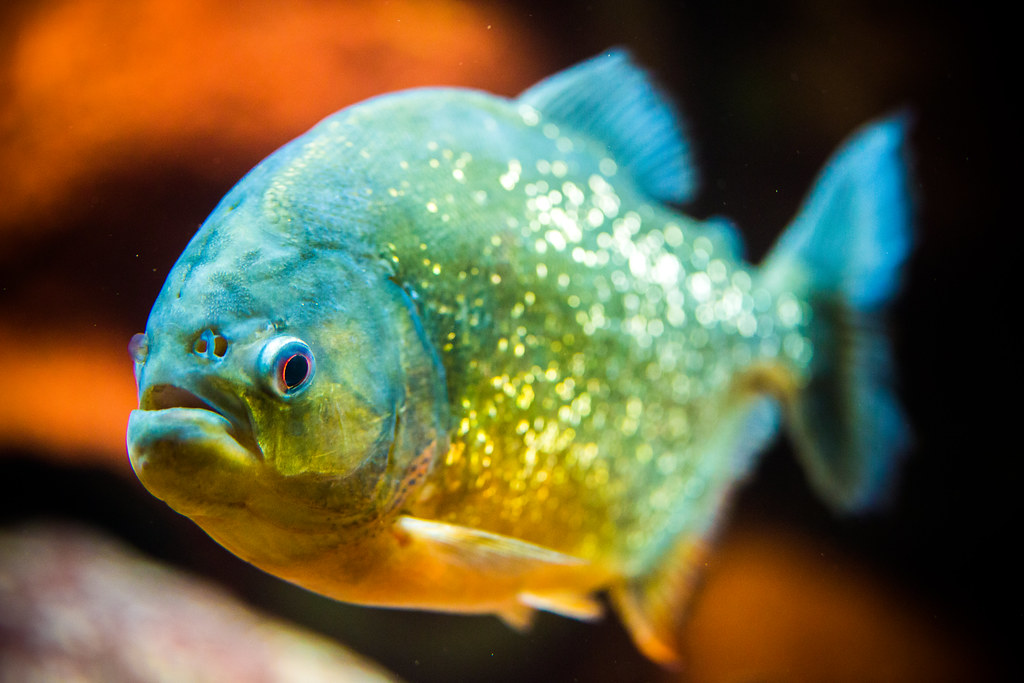Published on
Updated on

By Mariah Cox | Bond LSC
Hollywood cinema stereotypes leave us with a false vision of voracious piranhas that swim in packs and readily attack beachgoers with their sharp teeth and strong jaws.
This simply isn’t true, but their feeding habits are of particular interest to researchers because they can endure long periods of prey shortages and starvation, and scientists are starting to look at the genes behind that advantage.
Bond Life Science Center primary investigator Wes Warren brought his extensive knowledge of genome analysis to a research project with collaborators from Germany and Canada who looked at the genetic expression of the red-bellied piranha under fasting and well-fed diets.
Most fish are faced with short to long-term periods of starvation throughout their lifetime, which cause changes in behavior and the biochemistry of the fish. While piranhas do swim in schools, their feeding habits are much less horror-movie-like than popular culture suggests.
When feeding, piranhas travel in groups of 20-30 and tend to ambush prey in aquatic vegetation, forage the ocean floor for vegetation or invertebrates and opportunistically prey on sick or injured fish. Only rarely have “feeding frenzy” attacks occurred in which piranhas have fed on larger mammals.
But what is it in their genes that could lead to aggressive feeding behavior? The researchers were keen to discover the association of genes which drive aggressiveness and feeding behaviors.
More specifically, the researchers assigned the genes to biological pathways — interactions among molecules that lead to a change in a cell — to try to correlate the genes to certain evolutionary adaptations.
Biological pathways can be thought about in terms of a control room. Environmental cues have the ability to trigger pathway activation, turn genes on or off in the process, cause a cell to move or lead to biological changes within cells. Further, if a particular animal has a more active pathway, it may take much less to turn it on, so in the case of a piranha, it might be much easier to slow their metabolism or turn on a voracious feeding habit.
“For example, if we a say that piranhas have certain genes that appear to be under natural selection and they’re enriched for pathways in the metabolism, we could speculate the piranha lineage has developed some specific amino acid changes to this particular protein which we know is involved in metabolism that helps them deal with longer periods of starvation,” Warren said.
Before beginning research on piranhas, Warren was awarded a National Institutes of Health (NIH) grant to create genome assemblies of various aquatic species. The sequences of these genomes can even help the scientific community link the traits seen in these fish to human diseases.
Warren’s collaborators in Germany and Canada were particularly interested in studying the red-bellied piranha that inhabits neotropical freshwater rivers of northeastern Brazil and in the Paraguay and Parana basins. Previous research on this fish focused on dietary habits and social feeding behavior, but none had looked at the gene regulatory response during periods of food deprivation.
“This gene expression study is the first of its kind in piranhas and provides new information on changes in the genome under caloric restriction,” Warren said. “In particular, it provides evidence for the upregulation of genes involved in metabolism, suggesting an increased utilization of storage fuels and brain energy. The outcome in the piranha is consistent with that seen in other fish species.”
A database of pathways that represent common properties of a particular signaling module in cells helps the researchers link genes to behavior to see if they are enriched, such as a glucose metabolism pathway. From there, researchers can assess whether there is a similar biological process in humans.
“It’s possible to have these delayed periods of feeding where the liver could be adapting to that type of metabolism, and we’re always interested in trying to find unique angles to understand metabolism,” Warren said. “There are lots of metabolism-related diseases in humans, such as diabetes, so the goal is to understand if there’s any kind of evolutionary conservation of some of these pathways and how they respond to extremes in diet.”
The comparative process of discovery is indirect, but scientists have shown repeatedly that there is an evolutionarily conserved response to various stimuli in the environment. Warren says that it’s hard to make a sound biological inference by associating pathways of biological functions in other species, but scientists can use tactics to see enriched adaptations in species over what you would expect to see by chance.
“With the limited number of piranha samples we had for evaluation, we need to follow up these experiments through other types of validation to see if these genes are really driving the traits in piranhas. It’s always interesting to speculate about the linkage of those genes in the piranha driving the trait we examined, but it’s very challenging to prove without some kind of functional experiment,” Warren said.
This research was published in the journal “Genome Biology Evolution” in July 2019 and was funded by Deutsche Forschungsgemeinschaft, Julius-Maximilians-Universität Würzburg, the M.S.I. Foundation, the National Institutes of Health and the Natural Sciences and Engineering Research Council of Canada.